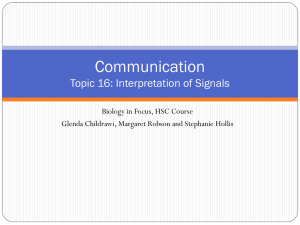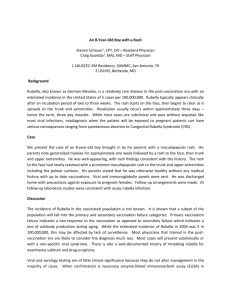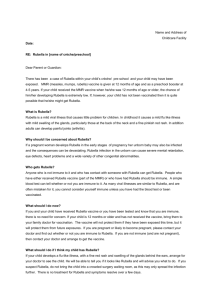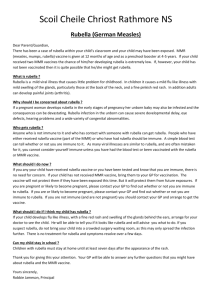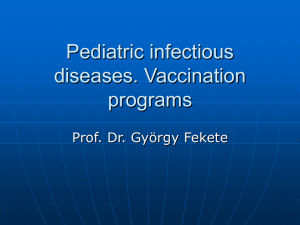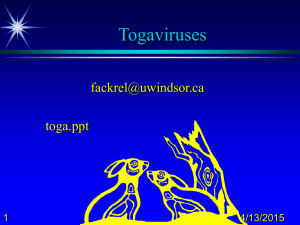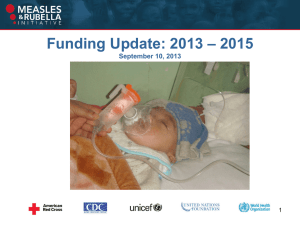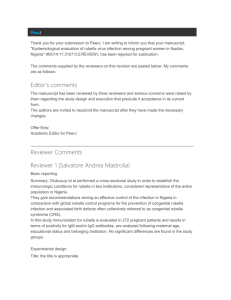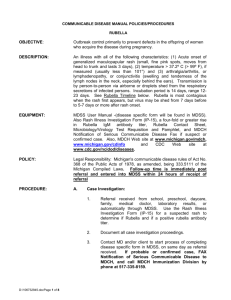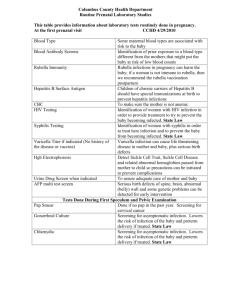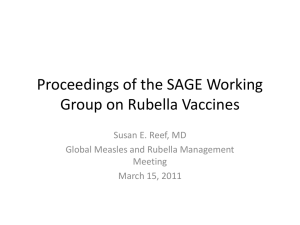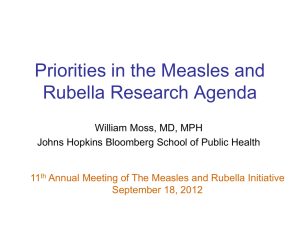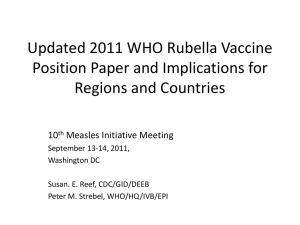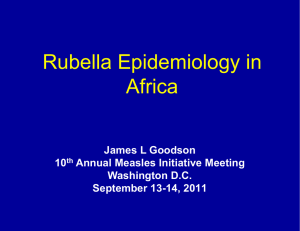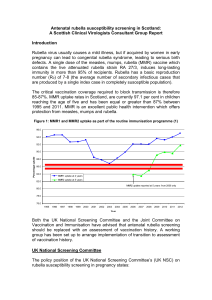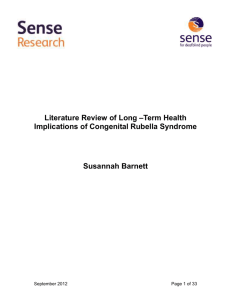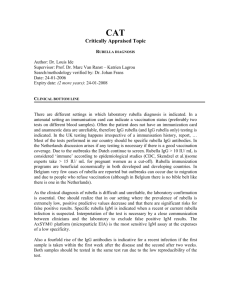Rubella Congenital Syndrome
advertisement
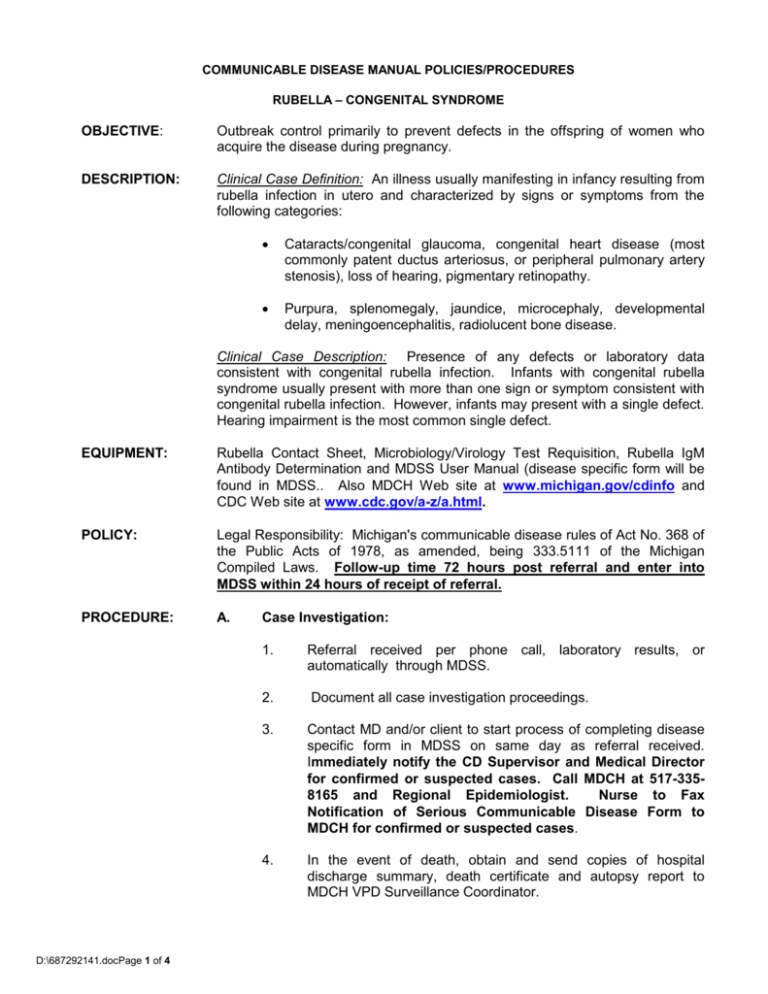
COMMUNICABLE DISEASE MANUAL POLICIES/PROCEDURES RUBELLA – CONGENITAL SYNDROME OBJECTIVE: Outbreak control primarily to prevent defects in the offspring of women who acquire the disease during pregnancy. DESCRIPTION: Clinical Case Definition: An illness usually manifesting in infancy resulting from rubella infection in utero and characterized by signs or symptoms from the following categories: Cataracts/congenital glaucoma, congenital heart disease (most commonly patent ductus arteriosus, or peripheral pulmonary artery stenosis), loss of hearing, pigmentary retinopathy. Purpura, splenomegaly, jaundice, microcephaly, developmental delay, meningoencephalitis, radiolucent bone disease. Clinical Case Description: Presence of any defects or laboratory data consistent with congenital rubella infection. Infants with congenital rubella syndrome usually present with more than one sign or symptom consistent with congenital rubella infection. However, infants may present with a single defect. Hearing impairment is the most common single defect. EQUIPMENT: Rubella Contact Sheet, Microbiology/Virology Test Requisition, Rubella IgM Antibody Determination and MDSS User Manual (disease specific form will be found in MDSS.. Also MDCH Web site at www.michigan.gov/cdinfo and CDC Web site at www.cdc.gov/a-z/a.html. POLICY: Legal Responsibility: Michigan's communicable disease rules of Act No. 368 of the Public Acts of 1978, as amended, being 333.5111 of the Michigan Compiled Laws. Follow-up time 72 hours post referral and enter into MDSS within 24 hours of receipt of referral. PROCEDURE: A. D:\687292141.docPage 1 of 4 Case Investigation: 1. Referral received per phone call, laboratory results, or automatically through MDSS. 2. Document all case investigation proceedings. 3. Contact MD and/or client to start process of completing disease specific form in MDSS on same day as referral received. Immediately notify the CD Supervisor and Medical Director for confirmed or suspected cases. Call MDCH at 517-3358165 and Regional Epidemiologist. Nurse to Fax Notification of Serious Communicable Disease Form to MDCH for confirmed or suspected cases. 4. In the event of death, obtain and send copies of hospital discharge summary, death certificate and autopsy report to MDCH VPD Surveillance Coordinator. B. C. Case Classification: 1. Suspected: A case with some compatible clinical findings, but not meeting the criteria for a probable case or confirmed case. 2. Probable: A case that is not laboratory confirmed and that has any two complications listed in the first bullet under Clinical Description, or one complication from the first bullet and one from the second bullet, and lacks evidence of any other etiology. 3. Confirmed: confirmed. 4. Infection Only: A case that demonstrates laboratory evidence of infection, but without any clinical symptoms or signs. 5. Comment: In probable cases, either or both of the eye-related findings (i.e., cataracts and congenital glaucoma) count as a single complication. In cases classified as infection only, if any compatible signs or symptoms (e.g., hearing loss) are identified later, the case is reclassified as confirmed. 6. See CDC Case Classification - 2010 (attachment 7419-A) for imported and U.S. acquired case classification included with this policy. Lab Criteria for Diagnosis 1. D. Congenital rubella in the newborn is laboratory confirmed by: a. Isolation of rubella virus in a positive PCR and from an appropriate clinical specimen (nasopharyngeal aspirate, throat swab, urine, or heparinized blood). Best results come from throat swabs; b. Demonstration of rubella-specific immunoglobulin M (IgM) antibody, or c. Infant rubella antibody level that persists at a higher level and for a longer period than expected from passive transfer of maternal antibody (i.e., rubella titer that does not drop at the expected rate of a twofold dilution per month). d. See # 7419C, “Lab Specimens Procedure” and “Recommended Lab Tests for Confirmation” attached with this policy. Control Measures 1. D:\687292141.docPage 2 of 4 A clinically compatible case that is laboratory Accurate diagnosis and reporting of congenital rubella syndrome and vaccine complications are extremely important in assessing the control of rubella. All birth defects in which rubella infection is etiologically suspected should be thoroughly investigated and reported to the Centers for Disease Control through the local or state health departments. E. D:\687292141.docPage 3 of 4 2. Patients with congenital rubella in day care should be considered contagious until they are one year old, unless nasopharyngeal and urine cultures are negative for rubella. 3. Mothers should be made aware of the potential hazard of their infants to susceptible pregnant contacts. 4. Pregnant women who have been exposed to rubella should be tested ASAP. 5. The routine use of immune globulin (IG) for postexposure prophylaxis of rubella in early pregnancy is not recommended. Administration of IG should be considered only if termination of the pregnancy is not an option. 6. Previously, rubella reimmunization was not recommended. However, in conjunction with the recently recommended twodose measles immunization schedule, two doses of Rubella vaccine are now given routinely. Upon orders of CD Supervisor and/or Medical Director, the following should be done quickly. 1. Revaccination should include siblings and persons born in or after 1957 who do not have proof of receiving one dose of rubella vaccine on or after first birthday or evidence of Rubella immunity. They should be immunized with one dose of MMR. 2. Record search of day care, etc., to determine who has not had two doses of MMR on or after 12 months of age. 3. EXCLUDE FROM DAY CARE all children not vaccinated with two doses of MMR vaccine on or after 12 months of age. May re-enter day care if proof provided of vaccination. Must have one month between MMR’s and unvaccinated children may reenter day care after having one MMR. If they are not vaccinated (per waiver or noncompliance) wait until 14 days after rash onset date of last reported case. 4. Health Department to provide clinic for all children who have not been vaccinated with two doses of Rubella vaccine on or after 12 months of age. 5. MMR’s should be used in day care centers for those who have not had one dose of Rubella or vaccinated prior to 12 months of age. 6. Mass revaccination of entire community not necessary and too costly. 7. F. Educate contacts and public. A “Question and Answer Rubella Information Sheet” from the Immunization Action Coalition is located with the Fact Sheets in this policy. MDSS Case Report Complete case investigation using disease specific form in MDSS. 1. Notify CD Supervisor that case report is ready for review. PHN will be notified if corrections are needed prior to closing case in MDSS. 2. CD Supervisor reviews case for completeness and closes MDSS case report. 3. Copy disease specific form and mail a copy to MDCH at the following address: Address: G. D:\687292141.docPage 4 of 4 Michigan Department of Community Health Immunization Division Attn: Immunization Coordinator 201 Townsend Street P.O. Box 30195 Lansing, MI 48913 Refer to current Red Book, current Control of Communicable Disease Manual, and VPD Guidelines at www.michigan.gov/immunize for more specific educational material.
